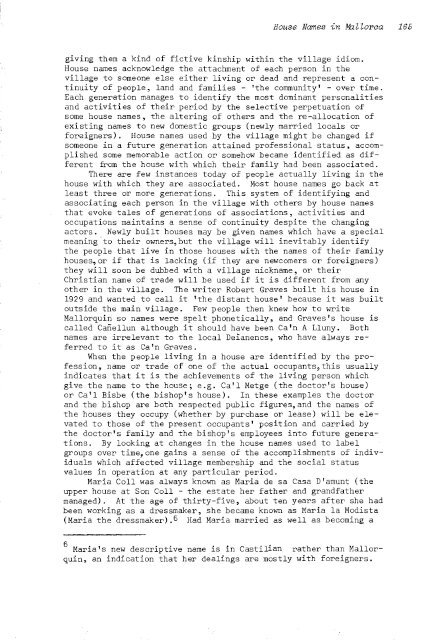CONTENTS NO.I - Institute of Social and Cultural Anthropology ...
CONTENTS NO.I - Institute of Social and Cultural Anthropology ...
CONTENTS NO.I - Institute of Social and Cultural Anthropology ...
Create successful ePaper yourself
Turn your PDF publications into a flip-book with our unique Google optimized e-Paper software.
House Names in Malloraa 165<br />
giving them a kind <strong>of</strong> fictive kinship within the village idiom.<br />
House names acknowledge the attachment <strong>of</strong> each person in the<br />
village to someone else either living or dead <strong>and</strong> represent a continuity<br />
<strong>of</strong> people, l<strong>and</strong> <strong>and</strong> families - 'the community' - over time.<br />
Each generation manages to identify the most dominant personalities<br />
<strong>and</strong> activities <strong>of</strong> their period by the selective perpetuation <strong>of</strong><br />
some house names, the altering <strong>of</strong> others <strong>and</strong> the re-allocation <strong>of</strong><br />
existing names to new domestic groups (newly married locals or<br />
foreigners). House names used by the village might be changed if<br />
someone in a future generation attained pr<strong>of</strong>essional status, accomplished<br />
some memorable action or somehow became identified as different<br />
from the house with which their family had been associated.<br />
There are few instances today <strong>of</strong> people actually living in the<br />
house with which they are associated. Most house names go back at<br />
least three or more generations. This system <strong>of</strong> identifying <strong>and</strong><br />
associating each person in the village with others by house names<br />
that evoke tales <strong>of</strong> generations <strong>of</strong> associations, activities <strong>and</strong><br />
occupations maintains a sense <strong>of</strong> continuity despite the changing<br />
actors. Newly built houses may be given names which have a special<br />
meaning 'to their owners,but the village will inevitably identify<br />
the people that live in those houses with the names <strong>of</strong> their family<br />
houses,or if that is lacking (if they are newcomers or foreigners)<br />
they will soon be dubbed with a village nic~name, or their<br />
Christian name <strong>of</strong> trade will be used if it is different from any<br />
other in the village. The writer Robert Graves built his house in<br />
1929 <strong>and</strong> wanted to call it 'the distant house' because it was built<br />
outside the main village. Few people then knew how to write<br />
Mallorquin so names were phonetically, <strong>and</strong> Graves's house is<br />
called Canellun although it should have been CaIn A Lluny. Both<br />
names are irrelevant to the local Deianencs, who have always referred<br />
to it as Ca'n Graves.<br />
When the people living in a house are identified by the pr<strong>of</strong>ession,<br />
name or trade <strong>of</strong> one <strong>of</strong> the actual occupants,this usually<br />
indicates that it is the achievements <strong>of</strong> the living person which<br />
the name to the house; e.g. Call Met.ge (the doctor's house)<br />
or Ca'l Bisbe (the bishop's house). In these examples the doctor<br />
<strong>and</strong> the bishop are both respected public figures,<strong>and</strong> the names <strong>of</strong><br />
the houses they occupy (whether by purchase or lease) will be elevated<br />
to those <strong>of</strong> the present occupants' position <strong>and</strong> carried by<br />
the doctor's family <strong>and</strong> the bishop's employees into future generations.<br />
By looking at changes in the house names used to label<br />
groups over time, one gains a sense <strong>of</strong> the accomplishments <strong>of</strong> individuals<br />
which affected village membership <strong>and</strong> the social status<br />
values in operation at any particular period.<br />
Maria Coll was always known as Maria de sa Casa D'amunt (the<br />
upper house at Son Coll - the estate her father <strong>and</strong> gr<strong>and</strong>father<br />
managed). At the age <strong>of</strong> thirty-five, about ten years after she had<br />
been working as a dressmaker, she became known as Maria la Modista<br />
(Maria the dressmaker).6 Had Maria married as well as becoming a<br />
6 Maria's new descriptive name is in Castilian rather than Mallorquin,<br />
an indication that her dealings are mostly with foreigners.

















